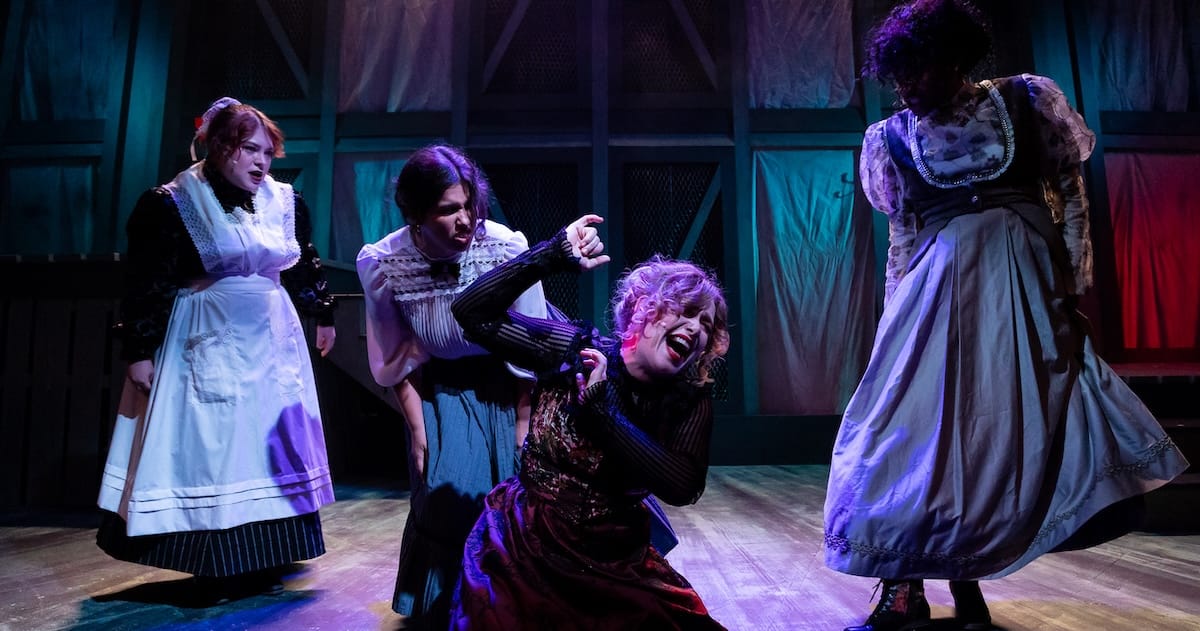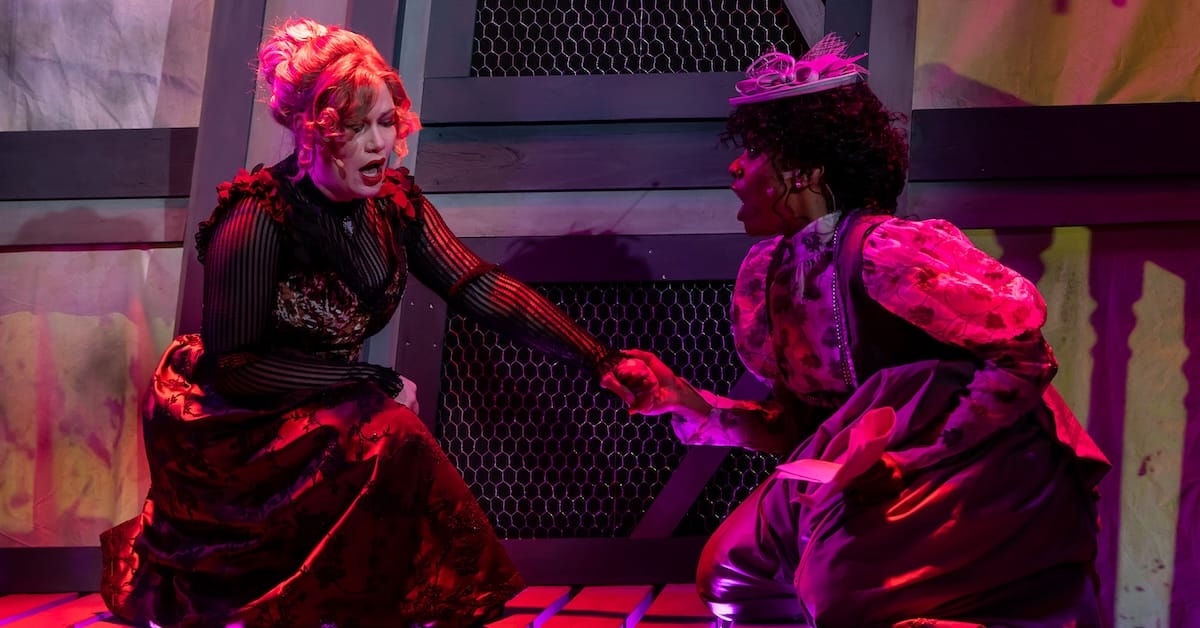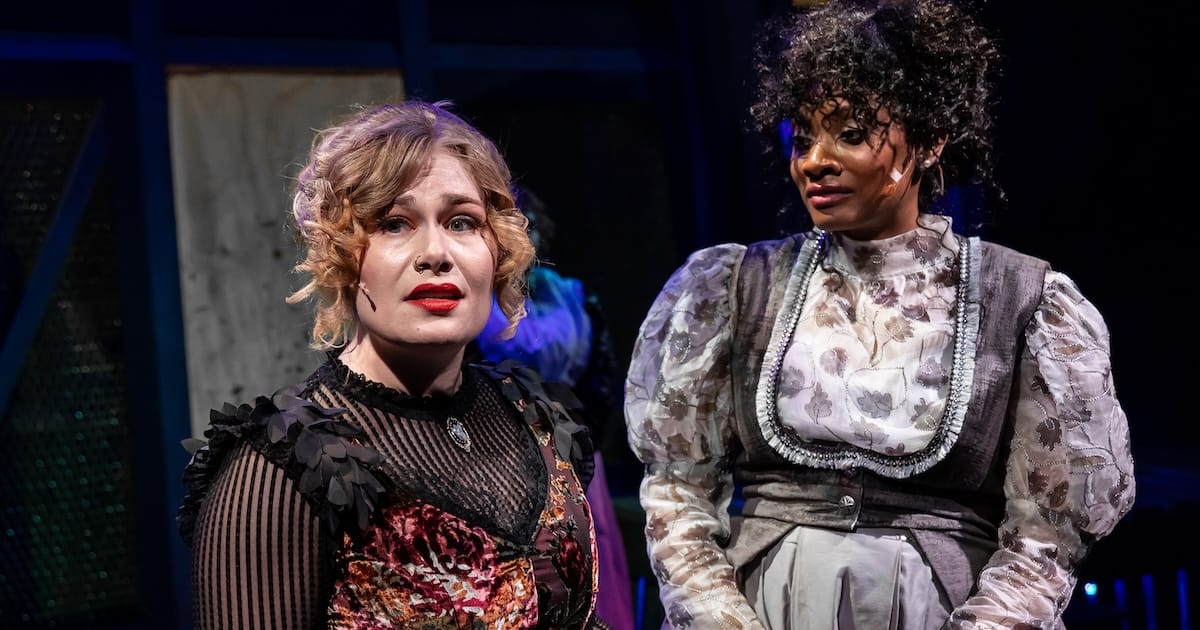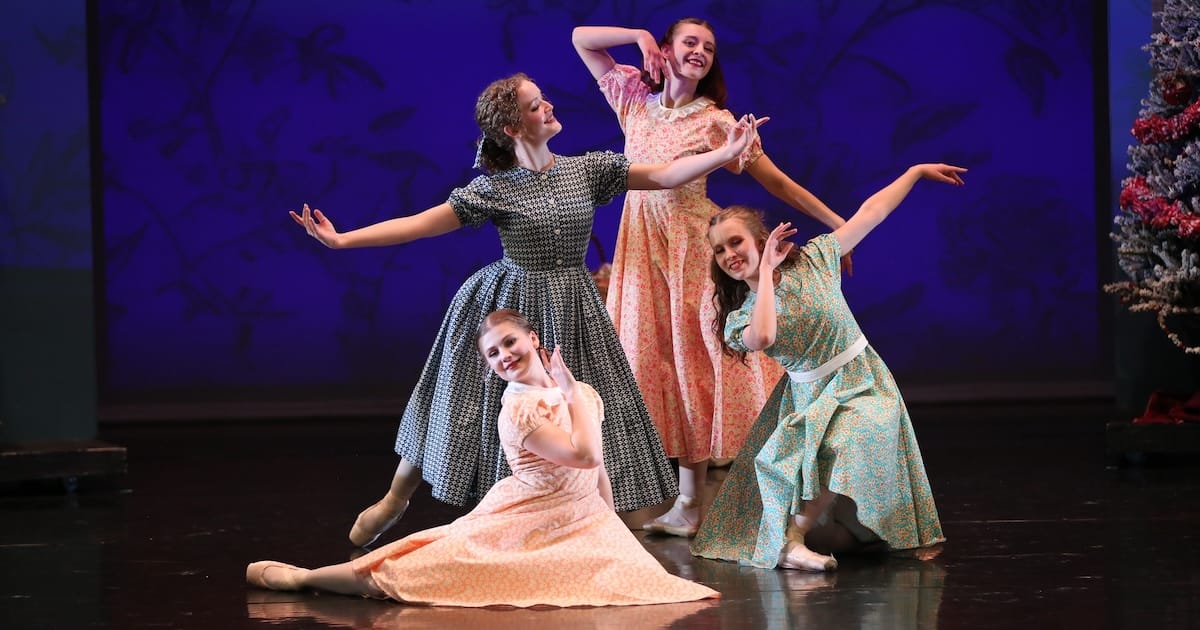The Fox’s musical about Lizzie Borden stuns with bold visuals and music but simmers more than it slashes, leaving a stylish but uneven impression.
Lizzie Borden may have wielded an axe, but in the Aurora Fox’s musical based on her story, it doesn’t swing straight for the blood. Instead, Lizzie trades gore for atmosphere, turning her notorious crime into an angsty, guitar-fueled tale of female rage and rebellion.
Lizzie is less a traditional musical than a rock opera in the vein of Jesus Christ Superstar. Directed by Talia Liccardello in the Fox’s intimate Studio Theater, the show’s marketing promises “Rage! Sex! Betrayal! Bloody murder!” but in reality, this is not a savage spectacle.
The infamous double-ax murders happen offstage near the end of Act I, and the story is less about the act itself than about the suffocating circumstances leading up to it and the fallout that follows. The plot revolves around Lizzie’s relationships with her sister Emma, maid Bridget and lover Alice, as well as the ways in which repression and simmering fury turn violent.
Rather than a bloody romp, Lizzie is a moodier, more introspective show that trades shock value for emotional excavation. At its best, this slower burn allows the music and design to build the gritty world, but it also means that stretches of the evening can sag, especially when performances feel too contained or scenes linger longer than their tension can bear.
Still, the premise, which frames Lizzie Borden as both victim and rock icon, remains compelling, even if the execution doesn’t always match the promise of its punk-fueled marketing.

Photo: RDGPhotography
Technical brilliance in a claustrophobic cage
Lizzie’s greatest strength at the Fox is its technical execution. Liccardello and scenic designer Brian Watson have transformed the black box into a claustrophobic, two-level house framed in what looks like chicken wire. Visually it suggests both domesticity and imprisonment.
The set doubles as a cage for its four female characters, who are trapped in the patriarchal world of the Borden household. Projections, co-designed by Liccardello and Watson, layer in haunting visual commentary — from family portraits that slowly bloom with blood to shifting textures that expand the story beyond the walls of the home.
Donna K. Debreceni leads a tight, five-piece band (keyboard, cello, guitars, bass and percussion) that drives the evening with precision and vigor. With 27 numbers across two acts, Lizzie is essentially sung-through, its jagged riffs and wailing harmonies balancing grunge energy with operatic sweep. From the audience, the sound design (by Curt Behm) achieves that delicate balance between live rock band and amplified vocals — never an easy feat in a small venue.
Lighting designer Ethan Newman deserves credit for making full use of the Studio Theater’s intimate space, keeping the performers visible even as they stalk through aisles and shadowy corners. Costume designer Charlotte Campbell grounds the characters in period silhouettes with punk flourishes, most notably Lizzie’s bold red-and-black dress, a visual cue that she is an outlier destined to rupture her world.
Meanwhile, Carrie Colton’s choreography comes alive in key ensemble moments, particularly the Act 2 closer, “Into Your Wildest Dreams,” where the women thrash together like a punky girl band.

Photo: RDGPhotography
Uneven performances in a fierce quartet
The four-woman cast is the engine of Lizzie, and while they deliver plenty of vocal firepower, the acting choices vary in effectiveness.
Emma Rebecca Maxfield, in the title role, shoulders the heaviest burden. The role demands a transformation from abused daughter to mythologized killer, but Maxfield’s choices leaned inward rather than outward. Much of her expression comes from her eyes, which makes her Lizzie often seem withdrawn when the text begs for volatility. Even in moments that should brim with anarchic release, such as her return from the murders, Maxfield remained oddly composed.
Vocally, her pitch faltered in Act I before finding steadier ground in Act II, but even when the voice soared, the emotional payoff lagged behind. The result was a Lizzie who felt watchful and self-contained, not the dangerous, unpredictable figure the narrative builds toward.
In sharp contrast, ThurZday’s Emma, Lizzie’s sister, brought a jolt of energy every time she stepped into the spotlight. While the role offers fewer featured moments, she seized each one, from dryly comic reactions in Act I to the Act II outburst “What the Fuck Now, Lizzie?” Her ability to convey panic, anger and love simultaneously gave the show its most human core.
Megan Schraeder’s Bridget offered another standout. More than a mere servant in this retelling, Bridget became a sardonic witness and occasional puppet master. Schraeder’s dry wit gave her lines bite, and her insinuating delivery suggested a woman who understood far more than she let on. Her sharp timing and strong vocals elevate moments that would otherwise fade into the background.
Helen Driesen, as Lizzie’s lover, Alice, sang with clarity and warmth, particularly in tender ballads like “If You Knew.” Yet her acting choices leaned so earnestly toward innocence that Alice’s Act II betrayal felt unearned. The shift required a flash of steel or duplicity that never appeared. Without that darker undertone, the betrayal seemed to happen to her rather than emerge from her, flattening the arc of a character meant to complicate Lizzie’s emotional world.
Pacing problems beneath the punk gloss
The structure of Lizzie itself also contributed to the night’s frustrations. The first act takes nearly an hour to work through its prologue and emotional setups, culminating in the murders, which occur offstage. Given the marketing’s emphasis on blood and chaos, this restraint may leave audiences surprised, if not disappointed.
Act II sharpens its focus on the aftermath: the failed cover-up, the trial and the betrayals that isolate Lizzie. Yet here the show sometimes stalls. Courtroom scenes devolve into static staging, with performers parked in place. The evening lasted just under two hours with intermission, which is longer than the script’s usual 90 minutes, giving the impression that the drama was diluted by unnecessary pauses.
Still, when the music roared and the ensemble united, particularly in raucous group numbers, the energy surged back. Lizzie thrives most when it embraces its rock-opera DNA, allowing the band to crash over the performers like a wave. In those moments, the show delivered the rebellious catharsis its premise promises, even if the quieter, slower passages kept it simmering more often than slashing.
Ultimately, Lizzie at the Aurora Fox is a taut, visually striking production that thrives when it lets its band and performers rage. But when the pace drags or emotions flatten, the show can feel caged by its own restraint. Like Lizzie herself, this musical is fascinating to watch, even if you wish it would let the ax swing harder.
A Colorado-based arts reporter originally from Mineola, Texas, who writes about the changing world of theater and culture, with a focus on the financial realities of art production, emerging forms and arts leadership. He’s the Managing Editor of Bucket List Community Cafe, a contributor to Denver Westword and Estes Valley Voice, resident storyteller for the Bonfils-Stanton Foundation and co-host of the OnStage Colorado Podcast. He holds an MBA and an MA in Theatre & Performance Studies from CU Boulder, and his reporting and reviews combine business and artistic expertise.





Leave A Comment